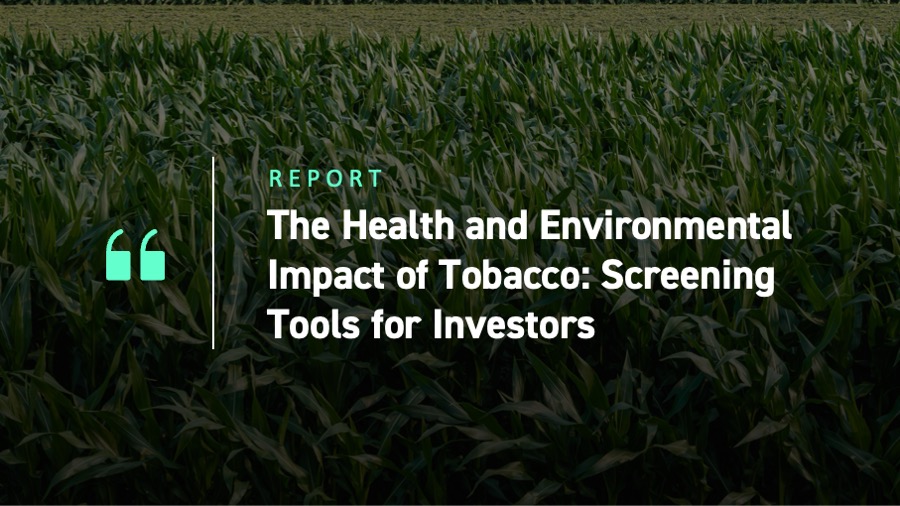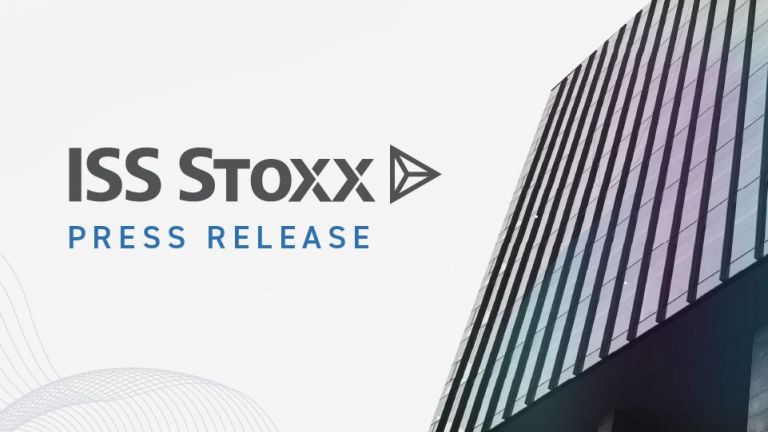The United Nations Sustainable Development Goals (SDGs) set reduction of tobacco use as a goal (Target 3A). Tobacco production and consumption are linked to negative impacts on the SDGs, such as deforestation, greenhouse gas emissions, and cancers and other illnesses. Avoiding these negative impacts while contributing to the SDGs’ tobacco reduction goal may be a concern for investors with an impact mandate.
To mark the 37th World No Tobacco Day, this piece reviews ISS ESG’s Sector-Based Screening, SDG Impact Rating, and SDG Solutions Assessment, which help investors account for tobacco-related concerns.
Tobacco and Sector-Based Screening
Sector-Based Screening (SBS) research identifies and measures companies’ involvement in tobacco through their business activities, specifying whether the companies are engaged in tobacco production, distribution, or services and the share of revenue generated from tobacco-related activities. SBS also measures companies’ involvement in tobacco through other metrics broken down by sub-categories of tobacco products, such as the share of revenue generated from traditional tobacco products, e-cigarettes, and heat-not-burn products.
Within the ISS ESG universe, SBS identified and assessed 1,089 companies involved in one or more types of tobacco-relevant business activities (Figure 1).
Figure 1: Number of Companies Covered by SBS Tobacco Assessment

Source: ISS ESG Data extracted from DataDesk, as of 13 May 2024
These tobacco business activities include the following:
- Production, such as manufacturing and producing tobacco products and growing or processing raw tobacco leaves
- Distribution, such as wholesale or retail distribution of tobacco products
- Provision of services, such as marketing and promoting tobacco products, supplying key products necessary to produce tobacco products, and licensing companies or brand names for use in tobacco products.
All three categories of tobacco-related business activities can pose risks for investors because of the significant negative effects tobacco products have on the environment and society.
Tobacco and the SDGs
International organizations, government agencies, and researchers have identified various negative impacts of tobacco production and consumption. Table 1 shows tobacco’s negative effects on different UN SDGs at different stages of tobacco’s life cycle.
Table 1: Environmental and Social Impact of Tobacco Life Cycle on UN SDGs
| STEPS OF TOBACCO LIFE CYCLE | EFFECTS | RESULTS | IMPACT ON SDG |
| Growing and curing | • Soil degradation • Deforestation • Loss of biodiversity • Pesticide and fertilizer usage exposes farm workers to hazardous chemicals • Tobacco farmers susceptible to green tobacco sickness | • Globally, 3.5 million hectares of land is used to grow tobacco • Around 90% of tobacco farming now takes place in low-income countries (LICs) • Tobacco production accounts for 5% of global deforestation • Prevalence of green tobacco sickness due to nicotine absorption ranged from 8% to 89% of tobacco farmers. | SDG – 15 SDG – 8   |
| Manufacturing and Transportation | • Greenhouse gas emissions • Hazardous waste emissions • Highly water intensive | • Production contributes to global warming through almost 84 million tonnes of CO2 equivalent emissions annually • Production causes 22 billion tons of water depletion • Per ISS ESG’s Water Risk Rating, all tobacco companies are rated as Medium to High risk. | SDG – 6  |
| Smoking | • Health and well-being | • Smoking causes about 90% of all lung cancer deaths in the United States. More women die annually from lung cancer due to smoking than from breast cancer. Smoking also causes about 80% of deaths from chronic obstructive pulmonary disease • Exposure to smoking can increase the risk of cardiovascular disease, cancer, and respiratory illnesses. | SDG – 3  |
| Disposing | • Environmental Pollution – Cigarettes and E-Cigarettes pollute water, air, and land with toxic chemicals, heavy metals, and residual nicotine. | • Cigarette butts are the most discarded waste item globally, accounting for about 766.6 million kilograms of toxic trash annually. • E-cigarettes and vaping devices contain batteries and non-biodegradable material. In 2022, more than 90 tonnes of lithium and 1,160 tonnes of copper were used globally in the production of vapes worth $5 billion, which is equal to a supply of more than 11,000 electric vehicle batteries and enough for 1.6 million home electric vehicle chargers, respectively. | SDG – 14  SDG – 15    |
One means to achieve the UN goal of reduced tobacco use is to strengthen the implementation of the WHO Framework Convention on Tobacco Control (WHO FCTC), ratified by 183 parties, including 50 WHO European member states.
Tobacco and SDG Impact Rating
ISS ESG’s SDG Impact Rating measures the effects of companies’ operations across the entire value chain. This information assists investors in minimizing negative impacts while identifying existing and emerging opportunities in companies’ products and services that contribute to the achievement of the SDGs. The company’s impact is measured thematically, following the SDG framework, as well as at an aggregate level. Impact ratings are determined across three pillars: products and services using ISS ESG’s SDG Solutions Assessment data, operations management using the ESG Corporate Rating, and controversies using Norm-Based Engagement.
The overall SDG Impact Rating ranges on a scale from -10 (significant negative impact) to +10 (significant positive impact), with an underlying classification into five impact categories:
Figure 2: SDG Impact Rating Scale


Source: ISS ESG
The ISS ESG SDG Impact Rating indicates both significant and limited negative impact for companies involved in tobacco production on SDG 3 – Good Health and Well-Being and for companies involved in tobacco distribution on SDG 14 – Life below Water and SDG 15 – Life on Land. A few companies also score as having a negative impact on SDG 8 – Decent Work and Economic Growth.
Tobacco Production: SDG 3 – Good Health and Well-Being
The U.S. Centers for Disease Control and Prevention (CDC) note that “Tobacco smoking causes cancer, heart disease, stroke, lung diseases, diabetes, and chronic obstructive pulmonary disease (COPD), which includes emphysema and chronic bronchitis.” According to the World Health Organization (WHO), about 7 million deaths per year are caused due to direct tobacco use. Roughly another 1.3 million deaths are the result of non-smokers being exposed to second-hand smoke.
WHO also estimates the total economic cost of smoking (from health expenditures and productivity losses combined) to be around $1.4 trillion per year, equivalent to 1.8% of the world’s annual GDP. Nearly 40% of this cost occurs in developing countries.
Given these effects of tobacco use, the ISS ESG SDG Impact Rating indicates significant and limited negative impact for companies involved in tobacco production on SDG 3 – Good Health and Well-Being.
Tobacco Distribution: SDG 14 – Life below Water and SDG 15 – Life on Land
Tobacco products pose environmental risks at different stages in their life cycle. Tobacco growing is water-intensive and dissolves chemicals into nearby waterways, polluting deep groundwater.
Under ISS ESG’s Water Risk Rating (WWR), tobacco companies are rated as high risk based on WWR – Water Risk Exposure. This factor is determined by company-specific classification of exposure to freshwater-related risks based on the geographical footprint of operations and risks in the supply chain. For example, a global water risk assessment conducted by Philip Morris International in 2023 concluded that 80% of its tobacco-growing areas had medium-to-high, high, or extremely high levels of exposure to physical risk.
Cigarette filter waste is made of cellulose acetate. This waste decomposes into microplastics and can take several years to degrade. Cigarette butts are the most common litter item collected: it is estimated that >80%, or over 4 trillion cigarette butts, are discarded each year as litter. Substances such as the leachate from the cigarette butts as well as unsmoked filters are extremely toxic to freshwater and marine animal life.
Tobacco companies were among the FMCG companies that were the leading producers of waste in 2021. An estimated 6 trillion cigarettes are manufactured annually. These cigarettes are marketed in about 300 billion packages made of paper, ink, cellophane, foil, and glue. The cartons and boxes used for tobacco products’ distribution and packing produced at least 2 million tonnes of waste in 2021. Smokeless tobacco products such as chewing tobacco and nicotine pouches are made of single-use plastic and metal for packaging. The result is solid waste, additional pressure on landfill, and toxic chemical leakage into the environment.
Tobacco companies mainly have limited negative SDG Impact ratings for SDG 14 and SDG 15.
Tobacco & Labour: SDG 8 – Decent Work and Economic Growth
A few tobacco companies score negatively for SDG 8 – Decent Work and Economic Growth. Tobacco production is based on global supply chains in which risks of labour rights violations are significant. The International Labor Organization (ILO) and United Nations have highlighted the dangers of child labour in tobacco growing.
Tobacco growing hinders children’s education and increases health risks due to use of pesticides and green tobacco leaves. Contact with the tobacco leaves leads to nicotine absorption through the skin, resulting in green tobacco sickness.
Conclusion
Tobacco companies generally score low on ISS ESG’s SDG Impact Rating. In addition to the specific SDG ratings already mentioned, ISS ESG’s Overall SDG Ratings show tobacco companies having limited or significant negative impact based on all 17 SDG Goals.
Investors may be concerned about the tobacco industry’s social and environmental impact. Other potential concerns are transitional (regulatory, reputational) risks associated with companies’ operations.
Tobacco companies may set emission targets as part of their actionable goals, which could contribute to more positive ESG profiles. Nevertheless, these emissions targets may apply only to emissions under companies’ “direct control,” without including emissions involved in the purchase of goods and services, transportation and distribution, capital goods, or activities that are influenced by companies but not controlled by them. A lack of comprehensive ESG data raises concerns about greenwashing.
As investors with an impact mandate consider how to approach tobacco companies, ISS ESG offers comprehensive screening and SDG solutions. The ISS ESG Sector-Based Screening research analyses companies’ involvement in the production and distribution of tobacco products as well as the services provided to these industries. ISS ESG’s SDG Impact Rating and SDG Solutions Assessment measure publicly traded funds and portfolios’ impact on the UN SDGs. Using ISS ESG expertise and data on corporate involvement and the impact on the tobacco industry, investors will be able to assess the social and enviromental impact of any actual or potential tobacco industry exposure.
Explore ISS ESG solutions mentioned in this report:
- Use ISS ESG Sector-Based Screening to assess companies’ involvement in a wide range of products and services such as alcohol, animal welfare, cannabis, for-profit correctional facilities, gambling, pornography, tobacco and more.
- Understand the impacts of your investments and how they support the UN Sustainable Development Goals with the ISS ESG SDG Solutions Assessment and SDG Impact Rating.
- Identify ESG risks and seize investment opportunities with the ISS ESG Corporate Rating.
- Develop engagement strategies, define achievable engagement objectives and manage your engagement process with ISS ESG’s Norm-Based Engagement Solution and Thematic Engagement Solution.
- Access a holistic assessment of companies’ exposure to freshwater-related risks using the ISS ESG Water Risk Rating.
By:
Pratik Akash, Associate, Sector-Based Screening, Screening & Controversies Research, ISS ESG
Israt Jahan, Analyst, Sustainable Development Goals Solutions Assessment, Screening & Controversies Research, ISS ESG
Yuhan Guo, Associate, Sector-Based Screening, Screening & Controversies Research, ISS ESG




